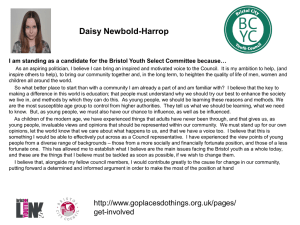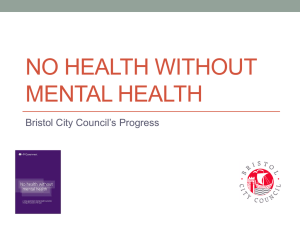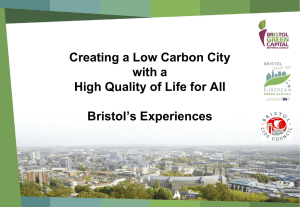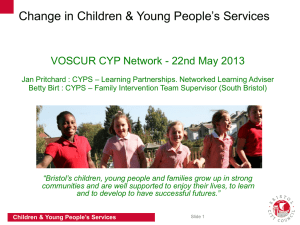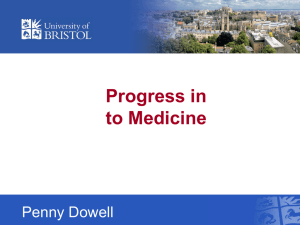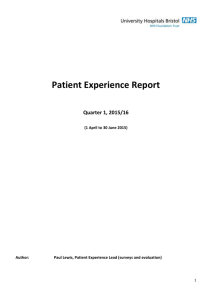Bristol Community Health Services
advertisement
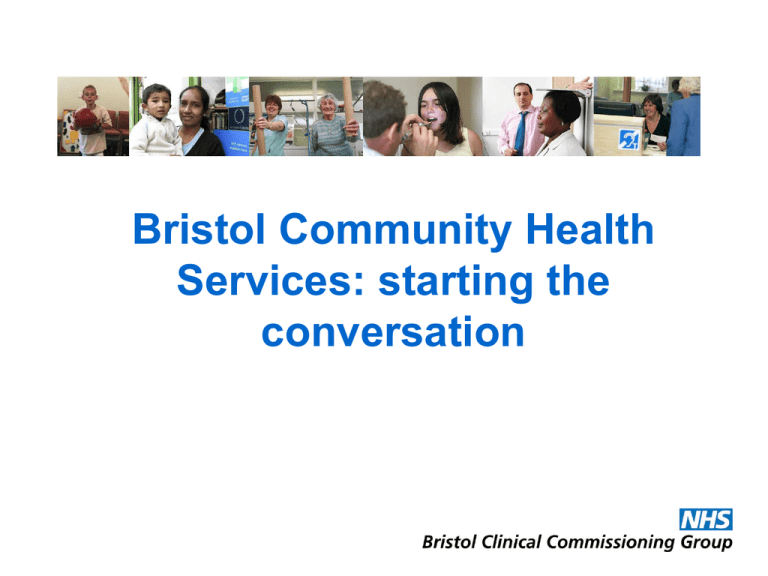
Bristol Community Health Services: starting the conversation Welcome and Introductions Dr Kirsty Alexander, CCG Governing Body Member Jill Shepherd, Chief Officer, Bristol CCG Setting the Scene Judith Brown, Operations Director, Bristol CCG Vareta Bryan, Service Director Care Provision, BCC Dr Chris Hine, Public Health Consultant, BCC The Opportunity Re-commissioning of adult Community Health Services in readiness for October 2016 • Bristol Community Health Contract (expires Oct 2016) • The establishment of the Better Care Fund (£30.3m in 2015-16) • The new GP contract • Service redesign informed by local communities • Better patient outcomes • The achievement of our vision, key ambitions and clinical outcomes Vision, Ambition and Clinical Outcomes • • • • • • Better Health and Sustainable Healthcare for Bristol More care for the frail and elderly provided closer to home Earlier cancer diagnosis Fewer diabetic amputations Reduction of emergency hospital admissions More joined up health and social care services Services designed to meet the needs of local communities Informed by the Patient Voice Community Health Services Include: – – – – Community Nurses Urgent care centres Specialist nurse services such as Tuberculosis Nurse Service Planned services such as Outpatient Musculoskeletal physiotherapy Intermediate Care Services (already jointly commissioned): – – – – Rapid response Planned rehabilitation and reablement Rehabilitation centres Hospital based services Joint Working – Health and Social Care • Jointly commissioned intermediate care service • Shared strategy for rehabilitation and reablement • Operational partnership between community health services and social care services • Aligned contracts and contracting processes • Registered nurses within the adult safeguarding team What do we know about the needs and expectations of the Bristol Population? • Data sources such as JSNA: on-going assessment of current & future health and social care needs of the local community • Joint process: Local Authority, NHS (CCG) and partner agencies – linked to Health and Wellbeing Board & Strategy Plus • Council consultations such as Quality of Life / Pupil Voice • Statistical profiles for wards and Neighbourhood Partnerships • Public Health analysis & community profiles • CCG assessments on condition-specific needs Bristol population overview • 432,500 people (19% children; 68% “working age”; 13% 65+) • Younger age profile (average age 33.7; national 39) – more <5’s and 20-45’s than national, less 50+ (see “pyramid” chart) • Rising population but unequal across city (9,300 Stoke Bishop to 19,700 Lawrence Hill - see 2012 ward map) Population of Bristol (all ages) 9344 to 11939 11940 to 14534 14535 to 17130 17131 to 19726 ONS 2012 OS data © Crown copyright & database rights 2013 Ordnance Survey 100023406 Bristol population characteristics • 16% of Bristol are BME, plus 6% non-British white (this 22% overall compares to 20% nationally and 12% in Bristol a decade ago) • Across city: 4% BME Whitchurch to 55% Lawrence Hill • 91 “main languages” in Bristol! 9% have one other than English; 1.5% do not speak English well • Disability: 71,700 people (16.7%) have a “limiting long-term illness or disability” – 8% (Clifton East) to 23% % of people whose day-to-day activities are limited (Hartcliffe) – see ward map • 40,100 are unpaid Carers (9.4%) • 13% of areas in Bristol (c60,000 people) are in the most deprived 10% in England 8 to 11 12 to 14 15 to 18 19 to 23 Census 2011 OS data © Crown copyright & database rights 2013 Ordnance Survey 100023406 Community issues • Life expectancy gap – between Bristol’s most & least deprived areas gap is 9.4 years for men & 5.8 for women • Map shows males by ward (same for women, but average 4-5 yrs more) – lighter is lower life expectancy • 50% obese or overweight but range 18-71% by ward (map on left, 2012) • Also ward differences in physical activity & healthy eating, + alcohol & smoking rates • Links to wider determinants (eg housing & planning) and areas of deprivation Future issues 2013 Health & Wellbeing Strategy has 10 priorities, including: • Improve integration across services • Child health - rising births all areas (highest 3 wards in Inner City) and “Special Needs” (esp in South) • Dementia - c4,400 people (1/2 over 85) – by 2020 rise 7%, but more 2020+ due to increasing over 85s • Social isolation – build community resilience and promote wellbeing Bristol population to 2021: project 40,000 (10.5%) increase – more in 2014 What do we need to decide? • How can we meet the needs and expectations of the Bristol population? • What services should we include in the re-commissioning? – existing community services – services currently provided in hospitals or other settings – new services • What do we want these services to achieve (outcomes)? • How can we join up services better? - Health, Social Care, Community and Voluntary Sector - Community and Hospital Care What would excellent adult community health services look like for the people of Bristol? Vision exercise Themes from Bristol GPs • Integrated services, teams and assessment • Single Point of Access / single phone number to ring where someone will take responsibility and sort out what is needed • Multidisciplinary teams – geographical, holding the budget, flexible, one team • Empowering local communities, developing community networks and support • Key workers / care co-ordinators • Using technology (telemedicine / FaceTime / Skype) Next steps • Collate and feedback affinity diagram via website (details to be sent to all attendees) • Develop a plan to involve client groups using information provided • To review and respond to questions and comments raised Thank you

